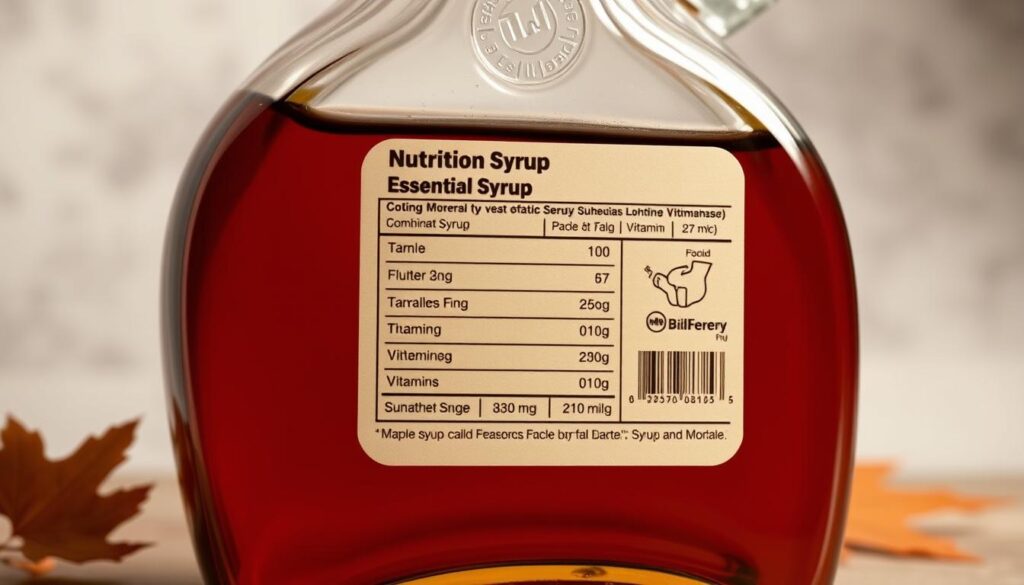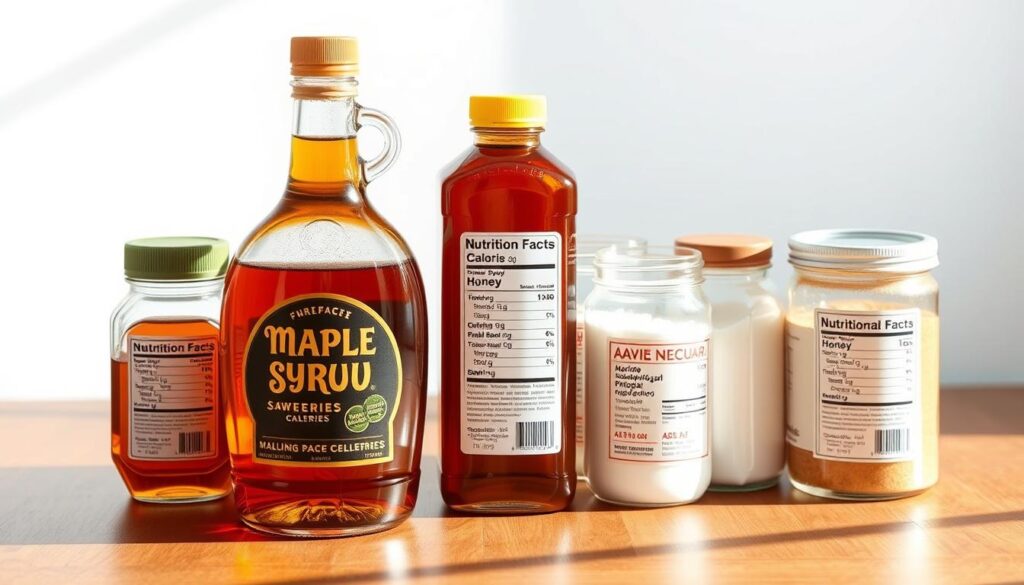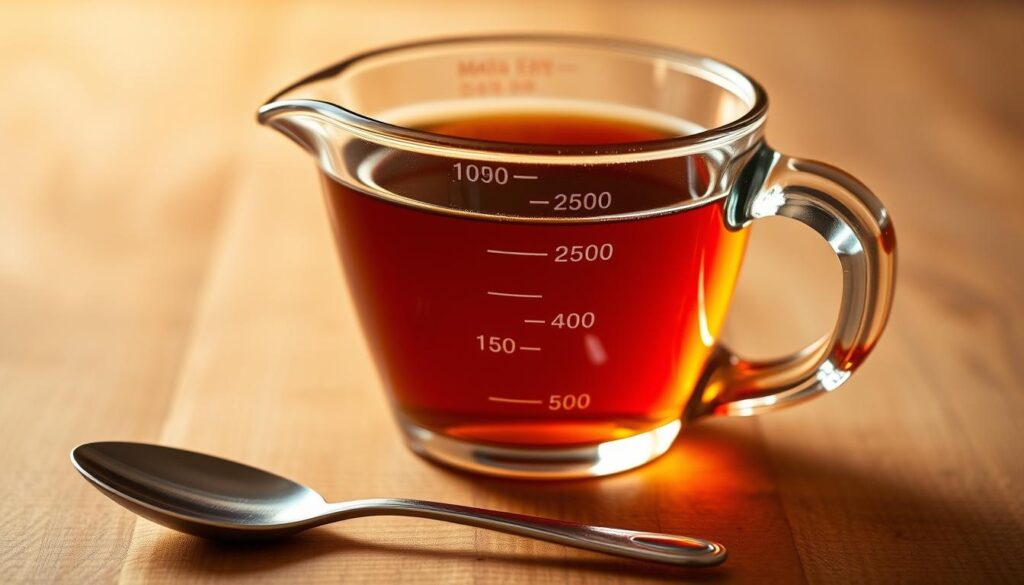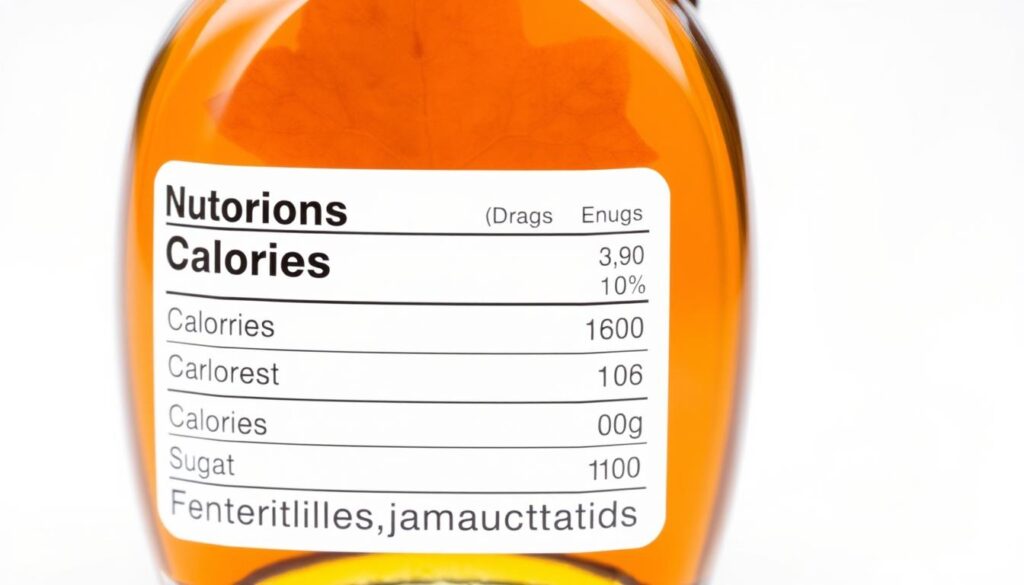Maple syrup is more than just sweet. It has a rich history and health benefits. Each drop is packed with nutrients that make it special.
Maple syrup is full of flavor and nutrients. It has minerals and compounds that other sugars don’t. It has about 52 calories per tablespoon, making it a concentrated energy source.
Sugarmakers in Vermont and Quebec make maple syrup the old way. They keep its nutritional value high. This shows maple syrup is more than just sugar.
Maple syrup has a unique metabolic profile. It has antioxidants and minerals that processed sugars don’t. Scientists are studying its health benefits, making it a good choice for those looking for natural sweeteners.
Knowing about maple syrup’s calories and nutrients helps you make better food choices. It’s great for health enthusiasts, chefs, or anyone who loves natural foods. Maple syrup is a tasty and healthy alternative to regular sweeteners.
Understanding Pure Maple Syrup: From Tree to Table
Maple syrup production is a fascinating journey. It turns tree sap into a delicious natural sweetener. This process is deeply rooted in North American tradition, blending old techniques with new innovation. Maple Syrup Nutrition Facts show it’s more than a sweetener – it’s a product of careful harvesting and processing.
The journey starts in maple forests. Skilled sugarmakers carefully select and tap sugar maple trees. These trees store energy in their roots during winter, making sap collection perfect.
Traditional Harvesting Methods
Historically, maple syrup production used some remarkable techniques:
- Indigenous peoples first discovered maple sap collection
- Early settlers learned tapping techniques from Native American communities
- Hand-carved wooden spouts were used to collect sap
- Sap was boiled in large iron kettles over open fires
Modern Production Techniques
Today, maple syrup production has evolved with technology while keeping traditional practices:
- Advanced vacuum systems improve sap collection
- Reverse osmosis machines concentrate sap more efficiently
- Precision evaporators control the boiling process
“Maple syrup is nature’s liquid gold, a testament to patience and craftsmanship” – Vermont Sugarmakers Association
Grading and Classifications
Maple syrup is classified by color and flavor intensity. Maple Syrup Nutrition Facts show different grades have unique characteristics:
- Golden Color: Mild, delicate flavor
- Amber Color: Rich, more pronounced maple taste
- Dark Color: Strong, robust maple flavor
- Very Dark Color: Intense, robust taste
Maple Syrup Calories: Basic Nutritional Facts
Knowing how many calories are in maple syrup helps us make better food choices. Pure maple syrup has a special nutritional profile. A tablespoon has about 52 calories, which is a lot of natural energy.
The Maple Syrup Nutrition Facts show its calorie makeup:
- Total calories per tablespoon: 52
- Carbohydrates: 13.4 grams
- Sugar content: 12.4 grams
- Protein: 0 grams
- Fat: 0 grams
Most of maple syrup’s calories come from natural sugars. It has minerals and antioxidants, unlike refined sugars. Because it’s so calorie-dense, it’s important to control how much we eat.
| Maple Syrup Grade | Calories per Tablespoon | Primary Characteristics |
|---|---|---|
| Golden Color | 52 | Lightest flavor, delicate taste |
| Amber Color | 52-53 | Rich, more pronounced maple flavor |
| Dark Color | 53-54 | Strong, robust maple taste |
Maple syrup calories stay the same across different grades. This makes it easy for those watching their diet to keep track.
While maple syrup provides calories, it offers more nutritional benefits compared to processed sugar alternatives.
The Glycemic Index of Maple Syrup
Knowing the sugar content in maple syrup is key for those watching their blood sugar. Maple syrup is special, not just for its taste but also for its health benefits.
Maple syrup’s glycemic index is between 54 and 67. This puts it in a middle range compared to other sweeteners. It’s a good choice for those looking for a different sweetener.
Blood Sugar Response Dynamics
Maple syrup causes a balanced insulin reaction. The sugar in it affects how fast glucose gets into the blood. Important factors include:
- Maple syrup’s natural mineral composition
- Concentration of simple sugars
- Processing method
Sweetener Comparative Analysis
Let’s look at how maple syrup stacks up against other sweeteners:
| Sweetener | Glycemic Index | Sugar Content |
|---|---|---|
| White Sugar | 65 | 100% sucrose |
| Honey | 58 | 80% sugar |
| Maple Syrup | 54-67 | 66% sucrose |
Maple syrup has natural sugars but is different from refined ones. Moderation is important when using it in your diet.
Essential Minerals and Vitamins in Maple Syrup

Maple syrup is more than a sweetener. It’s packed with essential minerals and vitamins. These nutrients make it a great choice for a healthy diet. Its unique flavor and nutritional benefits make it stand out from other sugars.
The mineral content in maple syrup is impressive. A single serving boosts key nutrients. These nutrients support many bodily functions.
- Manganese: Supports bone health and metabolism
- Zinc: Enhances immune system function
- Calcium: Crucial for strong bones and teeth
- Potassium: Regulates heart and muscle function
Vitamins in maple syrup add to its nutritional value. Riboflavin and thiamin are key for energy and cell health.
| Mineral/Vitamin | Amount per 100g | Key Benefits |
|---|---|---|
| Manganese | 2.91 mg | Supports metabolism and bone formation |
| Zinc | 0.04 mg | Boosts immune system |
| Calcium | 102 mg | Strengthens bones and teeth |
| Potassium | 212 mg | Regulates heart function |
Maple syrup is not a main source of nutrients. But it’s a better choice than refined sugars. It’s a smart addition to a balanced diet.
Antioxidant Properties and Health Benefits
Maple syrup is more than just sweet. It’s packed with antioxidants that offer amazing health benefits. These natural compounds in the syrup are being studied for their wellness effects.
The health perks of maple syrup come from its antioxidants. These include phenolic compounds and flavonoids. They help protect cells from damage and inflammation.
Types of Antioxidants Present
Maple syrup has several important antioxidants:
- Quebecol – a unique compound found exclusively in maple syrup
- Polyphenols – which help neutralize harmful free radicals
- Phenolic acids – supporting cellular health
Potential Health Advantages
Research shows these antioxidants may offer big health benefits. They could help lower heart disease risks, boost the immune system, and reduce inflammation.
Research-Backed Benefits
Studies have found links between maple syrup’s antioxidants and health. Researchers at universities in North America are exploring its benefits. They’re finding promising results for natural health support.
Comparing Calories: Maple Syrup vs Other Sweeteners

Looking into sweetener options, knowing about Maple Syrup Calories is key for those watching their health. A tablespoon of maple syrup has about 52 calories. This puts it close to other natural sweeteners in terms of calories.
Let’s compare Low-Calorie Maple Syrup with other sweeteners to see what we learn:
- Refined White Sugar: 49 calories per tablespoon
- Honey: 64 calories per tablespoon
- Agave Nectar: 60 calories per tablespoon
- Maple Syrup: 52 calories per tablespoon
Maple syrup isn’t the lowest in calories, but it has its perks. Its nutrient density makes it stand out from other sweeteners. Unlike refined sugar, maple syrup has minerals like manganese, zinc, and calcium.
Nutrition experts say choosing maple syrup is a smart move. It’s not just about calories. Its rich taste and health benefits beat out processed sweeteners.
Pure maple syrup offers more than sweetness—it adds real nutritional value.
Organic vs. Conventional Maple Syrup: Nutritional Differences
Maple syrup comes in two main types: organic and conventional. Organic Maple Syrup Calories have special qualities that make them different from the usual kind.
Those who make organic maple syrup follow strict rules. These rules help make a syrup that is pure and free from chemicals.
Certification Standards for Organic Maple Syrup
Getting organic maple syrup certified is a big deal. It means the syrup is good for the environment and for you:
- USDA Organic certification means no synthetic pesticides
- They use sustainable forest management
- They keep a close eye on tree and forest health
- No artificial additives or processing agents are used
Chemical Composition Variations
The differences in Organic Maple Syrup Calories and what’s in it can be small but important. Organic syrup might have more minerals and antioxidants.
| Characteristic | Organic Maple Syrup | Conventional Maple Syrup |
|---|---|---|
| Mineral Content | Higher mineral retention | Potential mineral loss |
| Antioxidant Levels | Potentially higher | Standard levels |
| Pesticide Residue | None | Possible trace amounts |
“Organic maple syrup represents more than just a sweetener—it’s a commitment to pure, natural nutrition.” – Maple Syrup Artisan
Even though they have the same calories, organic maple syrup is better for you and the planet. The careful way it’s made makes it a top choice for those who care about health and the environment.
Portion Control and Serving Sizes

Knowing the right serving size is key to managing maple syrup calories. A standard serving is about 1 to 2 tablespoons. This amount has around 50-100 calories. It’s important to be precise with your measurements.
Getting the right amount of maple syrup is essential for a balanced diet. Nutritionists suggest a few helpful tips:
- Use a measuring spoon for exact portion control
- Invest in a digital kitchen scale for precise measurements
- Practice visual estimation techniques
- Track calories in maple syrup using nutrition apps
Controlling portions doesn’t mean you have to give up maple syrup. Mindful consumption lets you enjoy it while keeping calories in check. Here are some tips:
- Drizzle it sparingly on pancakes or waffles
- Use it as a subtle flavor enhancer in marinades
- Replace refined sugars with small amounts of maple syrup
Knowing the right serving sizes helps you enjoy maple syrup without harming your health. By understanding its calorie content, you can indulge in its rich flavor while staying on track with your health goals.
Maple Syrup in Different Diets
Maple syrup is a versatile sweetener that fits into many diets. It’s great for those looking to add sweetness without compromising their health goals. This natural sweetener can be a key part of a balanced diet.
Vegan and Vegetarian Nutrition Perspectives
For those following plant-based diets, maple syrup is a perfect choice. It’s made from the sap of maple trees, making it vegan and vegetarian friendly. Its natural origins make it a better option than animal-based sweeteners.
- Completely plant-derived
- No animal products involved in production
- Rich in natural minerals
- Provides complex flavor profile
Paleo and Keto Diet Considerations
When it comes to paleo and keto diets, maple syrup is considered with caution. It’s not a main ingredient but can be used in small amounts.
| Diet Type | Maple Syrup Compatibility | Recommended Usage |
|---|---|---|
| Paleo Diet | Acceptable in moderation | Small quantities as natural sweetener |
| Keto Diet | Limited use | Minimal amounts, careful carbohydrate tracking |
Maple syrup is a better choice than refined sugars because it’s more nutritious. It’s important to control how much you use to stay on track with your diet.
Strategic consumption allows enjoyment without compromising dietary principles.
Storage and Caloric Stability
Keeping maple syrup’s nutritional value up requires smart storage. When stored right, maple syrup calories stay the same. This keeps the syrup’s quality and health perks intact.
For the best storage of maple syrup, consider these points:
- Store maple syrup in a cool, dark spot
- Use tight containers to stop contamination
- Put it in the fridge after opening to last longer
- Stay away from sunlight and heat
Storing maple syrup right is key to keeping its calories and nutrients. Unopened syrup can last a year in a pantry. But opened syrup should go in the fridge and be used in six months.
| Storage Location | Temperature Range | Expected Shelf Life |
|---|---|---|
| Pantry (Unopened) | 50-70°F | 12 months |
| Refrigerator (Opened) | 32-40°F | 6 months |
| Freezer | 0°F | Indefinite |
Tip: Always check for signs of spoilage, such as mold or off-odors, which can indicate compromised maple syrup calories and nutritional content.
Professional sugarmakers recommend transferring maple syrup to glass containers for optimal preservation of its natural qualities.
Watching over your syrup’s storage keeps its nutrients safe. This way, you can enjoy its delicious taste and health benefits for a longer time.
Cooking with Maple Syrup: Calorie-Conscious Tips
Looking into low-calorie maple syrup can change how you cook. It lets you enjoy sweet tastes while keeping your diet healthy. Maple syrup adds depth and richness to dishes without too many calories.
Clever cooks use low-calorie maple syrup to make tasty meals. They focus on portion control and smart substitutions.
Baking Substitutions
For baking with low-calorie maple syrup, try these tips:
- Replace sugar with 3/4 cup of maple syrup for every 1 cup of granulated sugar
- Reduce liquid ingredients by 2-4 tablespoons to maintain recipe consistency
- Lower oven temperature by 25 degrees to prevent over-browning
Recipe Modifications
Make your recipes healthier with these tweaks:
- Use pure maple syrup sparingly as a concentrated flavor enhancer
- Combine maple syrup with natural sweeteners like stevia for reduced calorie content
- Opt for grade A lighter syrups which typically contain fewer calories
With these tips, you can make healthier meals. You won’t have to give up on taste or creativity.
Common Myths About Maple Syrup Nutrition
Maple syrup has become popular for its health benefits. But, many false beliefs exist about its nutrition. Knowing these myths helps us make better food choices.
Some think maple syrup is a superfood full of nutrients. But, it’s not a magic health fix. The benefits of maple syrup are often overstated.
- Myth: Maple syrup is a significant source of vitamins
Reality: Maple syrup has some minerals, but it’s not a main source of nutrients. It should be seen as a sweetener, not a health supplement.
- Myth: Maple syrup is a completely healthy sugar alternative
Maple syrup does have health benefits, but it’s high in sugar. It’s important to use it in moderation, if you’re watching your sugar intake.
- Myth: All maple syrups are created equal
Different syrups have different nutritional values. Pure, minimally processed maple syrup is better than heavily refined ones.
Studies show maple syrup has antioxidants and minerals, but in small amounts. Using maple syrup instead of refined sugar is a good choice. But, it’s not a health food.
The key is understanding maple syrup as a natural sweetener with subtle nutritional advantages, not a miracle health remedy.
Nutrition experts say to enjoy maple syrup in small amounts as part of a healthy diet. Its rich taste can make meals better, but it offers little nutritional value.
Best Practices for Incorporating Maple Syrup in a Balanced Diet
Managing maple syrup sugar content is key. Experts say to treat it as a special sweetener. It can make meals better while keeping sugar intake in check.
Here are some smart ways to add maple syrup to your diet:
- Use it in small amounts to add flavor
- Pair it with protein to slow down sugar absorption
- Choose pure, minimally processed maple syrup types
- Swap refined sugars with maple syrup in recipes
It’s important to control how much maple syrup you eat. Experts say to limit it to 1-2 tablespoons a day. This way, you can enjoy its rich taste without hurting your diet.
Here are some creative ways to use maple syrup:
- Drizzle it over Greek yogurt
- Use it as a light marinade for lean proteins
- Add it to whole grain breakfasts
- Blend it into smoothies for sweetness
Knowing your dietary needs and getting advice from health experts is vital. Enjoying maple syrup in balance means appreciating its taste while staying healthy.
Conclusion
Maple syrup’s journey from forest to table is fascinating. It’s not just a sweetener; it’s packed with minerals, antioxidants, and trace nutrients. Knowing its caloric content and health benefits helps us make better food choices.
Maple syrup is a better choice than processed sugars. It’s natural and has less processing. It has minerals like manganese and zinc, and a lower glycemic index than refined sugar. This makes it a great choice for a balanced diet.
Maple syrup is more than a sweetener; it’s a tradition. By knowing its nutritional value, we can enjoy its taste while supporting good food practices. It’s all about knowing what we eat and how it fits into our diet.
Maple syrup is a standout in the world of natural sweeteners. Its taste and health benefits make it a great choice for a healthier diet. It’s a valuable part of modern eating habits.



